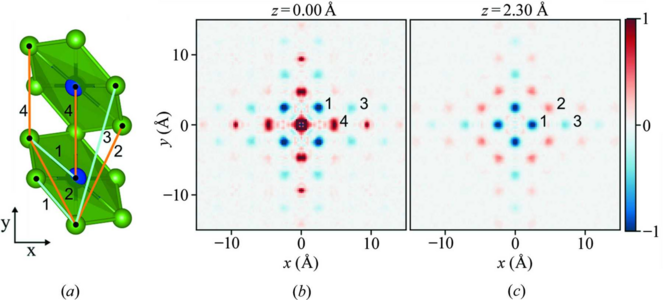We achieve groundbreaking results from diffraction experiments on home-grown crystals using data collected on one of the many diffractometers at Aarhus University and at large scale facilities across the world. Here you can find out more about the Advanced Crystallography research and recent publications within the Iversen group.

The 3D-δPDF can be considered as a generalized Patterson function giving information about interatomic vectors, and we have used it to determine the true structure of the very high performance environmentally benign thermoelectric material Cu2Se. The structure contains slabs with perfect local atomic order, but the slabs are disordered along the c-axis. An illustration of a half layer of Cu2-xSe showing close-packed Se (black) and and close-contact Cu (blue, red, green, yellow) is shown right. By interpreting the 3D-PDF features the structure was solved by hand, and this for the first time established a “crystallography of disorder”.
Recently, we have determined the vacancy ordering in high performance thermoelectric 19e half heusler alloys. In this high defect structure vacancies avoid other vacancies at neighboring and nearest neighboring sites, and the delicate local order of the defects has critical importance for the thermoelectric properties.
If neutron data are used, then the magnetic 3D-PDF can be determined and this provides a new way to study frustrated magnets. Normally magnetic frustration is modelled, e.g., with Monte Carlo methods, but this requires knowledge of an ordered atomic structure. In Bixbyite, (FexMn1-x)2O3, there is both atomic and magnetic disorder, and the two phenomena have a delicate coupling. We have derived the fundamental equations for studying frustrated magnets with 3D-mPDF, and mapped the frustrated magnetic structure in Bixbyite. The 3D-m(δ)PDF for bixbyite is shown below, where a selected portion of the structure showing numbered vectors between atoms is shown on the left, the 3D-m(δ)PDF for the z = 0 plane is center and the 3D-m(δ)PDF for the z = 2.30 Å plane is on the right.

Click on the links below to see recent Advanced Crystallography studies from the Iversen Group.